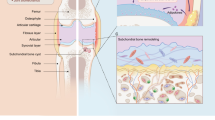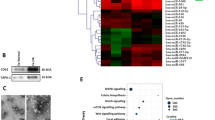Abstract
Osteoarthritis (OA) is a common degenerative joint disease that affects people worldwide. The interaction between fibroblast-like synoviocytes (FLSs) and chondrocytes may play a vital role in OA disease pathology. However, the underlying mechanisms by which FLSs exert regulatory effects on chondrocytes still need to be elucidated. Exosomes, small membrane vesicles secreted from living cells, are known to play a variety of roles in mediating cell-to-cell communication through the transferring of biological components such as non-coding RNAs and proteins. Here, we investigate the cellular processes of chondrocytes regulated by FLS-derived exosomes and the mechanisms of action underlying the functions of exosomes in OA pathogenesis. We observed that exosome-mediated cartilage repair was characterized by increased cell viability and migration as well as alleviated matrix degradation. Using chondrocyte cultures, the enhanced cellular proliferation and migration during exosome-mediated cartilage repair was linked to the exosomal lncRNA H19-mediated regulation of the miR-106b-5p/TIMP2 axis. Transfection of miR-106-5p mimics in chondrocytes significantly decreased cell proliferation and migration, promoted matrix degradation characterized by elevated MMP13 and ADAMTS5 expression, and reduced the expression of COL2A1 and ACAN in chondrocytes. Furthermore, we found that TIMP2 was directly regulated by miR-106-5p. Co-transfections of miR-106-5p mimics and TIMP2 resulted in higher levels of COL2A1 and ACAN, but lower levels of MMP13 and ADAMTS5. Together, these observations demonstrated that the lncRNA H19 may promote chondrocyte proliferation and migration and inhibit matrix degradation in OA possibly by targeting the miR-106b-5p/TIMP2 axis. In the future, H19 may serve as a potential therapeutic target for the treatment of OA.






Similar content being viewed by others
References
Guermazi, A., F.W. Roemer, D. Burstein, and D. Hayashi. 2011. Why radiography should no longer be considered a surrogate outcome measure for longitudinal assessment of cartilage in knee osteoarthritis. Arthritis Research & Therapy 13: 247.
Pan, L., Y. Zhang, N. Chen, and L. Yang. 2017. Icariin regulates cellular functions and gene expression of osteoarthritis patient-derived human fibroblast-like synoviocytes. International Journal of Molecular Sciences 18.
Pelletier, J.P., J. Martel-Pelletier, and S.B. Abramson. 2001. Osteoarthritis, an inflammatory disease: potential implication for the selection of new therapeutic targets. Arthritis and Rheumatism 44: 1237–1247.
Krenn, V., L. Morawietz, G.R. Burmester, R.W. Kinne, U. Mueller-Ladner, B. Muller, and T. Haupl. 2006. Synovitis score: discrimination between chronic low-grade and high-grade synovitis. Histopathology 49: 358–364.
Ding, X., Y. Zhang, Y. Huang, S. Liu, H. Lu, and T. Sun. 2015. Cadherin-11 involves in synovitis and increases the migratory and invasive capacity of fibroblast-like synoviocytes of osteoarthritis. International Immunopharmacology 26: 153–161.
Nair, A., V. Kanda, C. Bush-Joseph, N. Verma, S. Chubinskaya, K. Mikecz, T.T. Glant, A.M. Malfait, M.K. Crow, G.T. Spear, A. Finnegan, and C.R. Scanzello. 2012. Synovial fluid from patients with early osteoarthritis modulates fibroblast-like synoviocyte responses to toll-like receptor 4 and toll-like receptor 2 ligands via soluble cd14. Arthritis and Rheumatism 64: 2268–2277.
Kloesch, B., M. Liszt, D. Krehan, J. Broell, H. Kiener, and G. Steiner. 2012. High concentrations of hydrogen sulphide elevate the expression of a series of pro-inflammatory genes in fibroblast-like synoviocytes derived from rheumatoid and osteoarthritis patients. Immunology Letters 141: 197–203.
Fu, Z., P. Liu, D. Yang, F. Wang, L. Yuan, Z. Lin, and J. Jiang. 2012. Interleukin-18-induced inflammatory responses in synoviocytes and chondrocytes from osteoarthritic patients. International Journal of Molecular Medicine 30: 805–810.
Fernandes, J.C., J. Martel-Pelletier, and J.P. Pelletier. 2002. The role of cytokines in osteoarthritis pathophysiology. Biorheology 39: 237–246.
Hasegawa, A., H. Nakahara, M. Kinoshita, H. Asahara, J. Koziol, and M.K. Lotz. 2013. Cellular and extracellular matrix changes in anterior cruciate ligaments during human knee aging and osteoarthritis. Arthritis Research & Therapy 15: R29.
Steenvoorden, M.M., R.A. Bank, H.K. Ronday, R.E. Toes, T.W. Huizinga, and J. DeGroot. 2007. Fibroblast-like synoviocyte-chondrocyte interaction in cartilage degradation. Clinical and Experimental Rheumatology 25: 239–245.
Huh, Y.H., G. Lee, W.H. Song, J.T. Koh, and J.H. Ryu. 2015. Crosstalk between FLS and chondrocytes is regulated by HIF-2alpha-mediated cytokines in arthritis. Experimental & Molecular Medicine 47: e197.
Cui, Z., S. Ren, J. Lu, F. Wang, W. Xu, Y. Sun, M. Wei, J. Chen, X. Gao, C. Xu, J.H. Mao, and Y. Sun. 2013. The prostate cancer-up-regulated long noncoding RNA plncrna-1 modulates apoptosis and proliferation through reciprocal regulation of androgen receptor. Urologic Oncology 31: 1117–1123.
Akhtar, N., Z. Rasheed, S. Ramamurthy, A.N. Anbazhagan, F.R. Voss, and T.M. Haqqi. 2010. Microrna-27b regulates the expression of matrix metalloproteinase 13 in human osteoarthritis chondrocytes. Arthritis and Rheumatism 62: 1361–1371.
Nugent, M. 2016. MicroRNAs: exploring new horizons in osteoarthritis. Osteoarthritis and Cartilage 24: 573–580.
Gupta, R.A., N. Shah, K.C. Wang, J. Kim, H.M. Horlings, D.J. Wong, M.C. Tsai, T. Hung, P. Argani, J.L. Rinn, Y. Wang, P. Brzoska, B. Kong, R. Li, R.B. West, M. van de Vijver, S. Sukumar, and H.Y. Chang. 2010. Long non-coding RNA HOTAIR reprograms chromatin state to promote cancer metastasis. Nature 464: 1071–1076.
Chang, T., J. Xie, H. Li, D. Li, P. Liu, and Y. Hu. 2016. MicroRNA-30a promotes extracellular matrix degradation in articular cartilage via downregulation of Sox9. Cell Proliferation 49: 207–218.
Wu, J., M. Zou, A. Ping, Z. Deng, and L. Cai. 2018. MicroRNA-449a upregulation promotes chondrocyte extracellular matrix degradation in osteoarthritis. Biomedicine & Pharmacotherapy 105: 940–946.
Li, Y.F., S.H. Li, Y. Liu, and Y.T. Luo. 2017. Long noncoding RNA CIR promotes chondrocyte extracellular matrix degradation in osteoarthritis by acting as a sponge for Mir-27b. Cellular Physiology and Biochemistry 43: 602–610.
Sun, H., G. Wang, Y. Peng, Y. Zeng, Q.N. Zhu, T.L. Li, J.Q. Cai, H.H. Zhou, and Y.S. Zhu. 2015. H19 lncRNA mediates 17beta-estradiol-induced cell proliferation in MCF-7 breast cancer cells. Oncology Reports 33: 3045–3052.
Lv, J., Y.Q. Yu, S.Q. Li, L. Luo, and Q. Wang. 2014. Aflatoxin b1 promotes cell growth and invasion in hepatocellular carcinoma HepG2 cells through h19 and e2f1. Asian Pacific Journal of Cancer Prevention 15: 2565–2570.
Liu, C., Z. Chen, J. Fang, A. Xu, W. Zhang, and Z. Wang. 2016. H19-derived miR-675 contributes to bladder cancer cell proliferation by regulating p53 activation. Tumour Biology 37: 263–270.
Steck, E., S. Boeuf, J. Gabler, N. Werth, P. Schnatzer, S. Diederichs, and W. Richter. 2012. Regulation of h19 and its encoded microRNA-675 in osteoarthritis and under anabolic and catabolic in vitro conditions. Journal of Molecular Medicine (Berlin, Germany) 90: 1185–1195.
Fattahi, M., N. Rezaei, F.S. Nematalahi, V. Shaygannejad, S. Fouladi, L. Karimi, F. Fathi, L. Dehghani, O. Mirmosayyeb, and N. Eskandari. 2019. MicroRNA-29b variants and MxA expression change during interferon beta therapy in patients with relapsing-remitting multiple sclerosis. Multiple Sclerosis and Related Disorders 35: 241–245.
Tao, R., X.X. Fan, H.J. Yu, G. Ai, H.Y. Zhang, H.Y. Kong, Q.Q. Song, Y. Huang, J.Q. Huang, and Q. Ning. 2018. MicroRNA-29b-3p prevents Schistosoma japonicum-induced liver fibrosis by targeting COL1A1 and COL3A1. Journal of Cellular Biochemistry 119: 3199–3209.
Vandooren, B., T. Cantaert, M. ter Borg, T. Noordenbos, R. Kuhlman, D. Gerlag, T. Bongartz, K. Reedquist, P.P. Tak, and D. Baeten. 2008. Tumor necrosis factor alpha drives cadherin 11 expression in rheumatoid inflammation. Arthritis and Rheumatism 58: 3051–3062.
Gosset, M., F. Berenbaum, S. Thirion, and C. Jacques. 2008. Primary culture and phenotyping of murine chondrocytes. Nature Protocols 3: 1253–1260.
Qin, J., L. Shang, A.S. Ping, J. Li, X.J. Li, H. Yu, J. Magdalou, et al. 2012. TNF/TNFR signal transduction pathway-mediated anti-apoptosis and anti-inflammatory effects of sodium ferulate on Il-1beta-induced rat osteoarthritis chondrocytes in vitro. Arthritis Research & Therapy 14: R242.
Zhang, G., Y. Sun, Y. Wang, R. Liu, Y. Bao, and Q. Li. 2016. MiR-502-5p inhibits Il-1beta-induced chondrocyte injury by targeting TRAF2. Cellular Immunology 302: 50–57.
Firestein, G.S. 1996. Invasive fibroblast-like synoviocytes in rheumatoid arthritis. Passive responders or transformed aggressors? Arthritis and Rheumatism 39: 1781–1790.
Neidhart, M., C.A. Seemayer, K.M. Hummel, B.A. Michel, R.E. Gay, and S. Gay. 2003. Functional characterization of adherent synovial fluid cells in rheumatoid arthritis: destructive potential in vitro and in vivo. Arthritis and Rheumatism 48: 1873–1880.
Hu, W., W. Zhang, F. Li, F. Guo, and A. Chen. 2016. MiR-139 is up-regulated in osteoarthritis and inhibits chondrocyte proliferation and migration possibly via suppressing EIF4G2 and IGF1R. Biochemical and Biophysical Research Communications 474: 296–302.
Zhang, S., S.J. Chuah, R.C. Lai, J.H.P. Hui, S.K. Lim, and W.S. Toh. 2018. MSC exosomes mediate cartilage repair by enhancing proliferation, attenuating apoptosis and modulating immune reactivity. Biomaterials 156: 16–27.
Kato, T., S. Miyaki, H. Ishitobi, Y. Nakamura, T. Nakasa, M.K. Lotz, and M. Ochi. 2014. Exosomes from Il-1beta stimulated synovial fibroblasts induce osteoarthritic changes in articular chondrocytes. Arthritis Research & Therapy 16: R163.
Wang, Y., D. Yu, Z. Liu, F. Zhou, J. Dai, B. Wu, J. Zhou, et al. 2017. Exosomes from embryonic mesenchymal stem cells alleviate osteoarthritis through balancing synthesis and degradation of cartilage extracellular matrix. Stem Cell Research & Therapy 8: 189.
Li, Y., S. Li, Y. Luo, Y. Liu, and N. Yu. 2017. LncRNA PVT1 regulates chondrocyte apoptosis in osteoarthritis by acting as a sponge for miR-488-3p. DNA and Cell Biology 36: 571–580.
Dang, X., L. Lian, and D. Wu. 2018. The diagnostic value and pathogenetic role of lncRNA-ATB in patients with osteoarthritis. Cellular & Molecular Biology Letters 23: 55.
Xu, J., and Y. Xu. 2017. The lncRNA MEG3 downregulation leads to osteoarthritis progression via miR-16/SMAD7 axis. Cell & Bioscience 7: 69.
Hu, Y., S. Li, and Y. Zou. 2019. Knockdown of lncRNA h19 relieves LPS-induced damage by modulating miR-130a in osteoarthritis. Yonsei Medical Journal 60: 381–388.
Ni, S., W. Weng, M. Xu, Q. Wang, C. Tan, H. Sun, L. Wang, D. Huang, X. du, and W. Sheng. 2018. MiR-106b-5p inhibits the invasion and metastasis of colorectal cancer by targeting CTSA. Onco Targets Ther 11: 3835–3845.
Shi, D.M., X.Y. Bian, C.D. Qin, and W.Z. Wu. 2018. MiR-106b-5p promotes stem cell-like properties of hepatocellular carcinoma cells by targeting PTEN via PI3K/Akt pathway. Onco Targets Ther 11: 571–585.
Li, P., M. Shen, F. Gao, J. Wu, J. Zhang, F. Teng, and C. Zhang. 2017. An antagomir to microRNA-106b-5p ameliorates cerebral ischemia and reperfusion injury in rats via inhibiting apoptosis and oxidative stress. Molecular Neurobiology 54: 2901–2921.
Tao, Y., Z. Wang, L. Wang, J. Shi, X. Guo, W. Zhou, X. Wu, Y. Liu, W. Zhang, H. Yang, Q. Shi, Y. Xu, and D. Geng. 2017. Downregulation of miR-106b attenuates inflammatory responses and joint damage in collagen-induced arthritis. Rheumatology (Oxford) 56: 1804–1813.
Meszaros, E., and C.J. Malemud. 2012. Prospects for treating osteoarthritis: enzyme-protein interactions regulating matrix metalloproteinase activity. Ther Adv Chronic Dis 3: 219–229.
Clutterbuck, A.L., K.E. Asplin, P. Harris, D. Allaway, and A. Mobasheri. 2009. Targeting matrix metalloproteinases in inflammatory conditions. Current Drug Targets 10: 1245–1254.
Author information
Authors and Affiliations
Corresponding author
Additional information
Publisher’s Note
Springer Nature remains neutral with regard to jurisdictional claims in published maps and institutional affiliations.
Rights and permissions
About this article
Cite this article
Tan, F., Wang, D. & Yuan, Z. The Fibroblast-Like Synoviocyte Derived Exosomal Long Non-coding RNA H19 Alleviates Osteoarthritis Progression Through the miR-106b-5p/TIMP2 Axis. Inflammation 43, 1498–1509 (2020). https://doi.org/10.1007/s10753-020-01227-8
Published:
Issue Date:
DOI: https://doi.org/10.1007/s10753-020-01227-8




